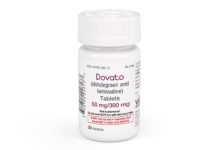Eight infants who began antiretroviral therapy (ART) during the first year of life and maintained viral suppression for 7 years had no evidence of ongoing HIV replication or consequent viral evolution [1]. The findings are important because low viral diversity in just-infected infants provides a good background against which to probe for HIV evolution resulting from viral replication.
 National Cancer Institute (NCI) researchers recently found no evidence of HIV evolution in 13 of 14 adults with long-term viral control on ART [2]. But a recent 3-person study at Northwestern University calculated that HIV evolution occurs during suppressive ART at a rate of 6×10(-4) to 1×10(-3) mutations per site per month because of ongoing HIV replication in lymph nodes and migration of newly infected T cells from lymph nodes to blood [3].
National Cancer Institute (NCI) researchers recently found no evidence of HIV evolution in 13 of 14 adults with long-term viral control on ART [2]. But a recent 3-person study at Northwestern University calculated that HIV evolution occurs during suppressive ART at a rate of 6×10(-4) to 1×10(-3) mutations per site per month because of ongoing HIV replication in lymph nodes and migration of newly infected T cells from lymph nodes to blood [3].
Collaborating with researchers at Stellenbosch University and the University of Pittsburgh, the NCI investigators turned to viral samples from South African children treated in the first year of life in the CHER trial [4]. These 8 children had no viral replication through 7 years of therapy. Because they began treatment in the first months of life, they had very low viral diversity when ART began and thus offered a nearly clean viral evolutionary slate against which to track later viral evolution. The researchers also studied 2 control children who had a detectable viral load for 1 to 3 years before starting ART and thus had a more evolved viral population when they started ART.
All children began therapy with zidovudine/lamivudine plus either lopinavir/ritonavir or efavirenz, and all reached and maintained a viral load below 40 copies. The 8 children treated in the first months of life were 1.8 to 9.9 months old when ART began and 83.4 to 111.5 months old (7 to 9 years) when they gave their long-term on-ART sample. The 2 control children who began ART after a longer period of viral replication were 10.9 and 17.4 months old when treatment started and 99.7 and 105.9 months old (8 to almost 9 years) at the long-term sampling point.
The investigators used three sensitive methods to probe for evidence of viral evolution: (1) calculation of average pairwise distance for sequence diversification, (2) panmixia testing for sequence divergence, and (3) construction of maximum-likelihood trees to measure “root-to-tip” distances for emerging new variants.
By all three methods, the 2 control children had clear evidence of viral evolution during suppressive ART. But the 8 children who started ART early had no evidence of viral evolution. Through about 100 months of age, viral diversity measured by average pairwise distance rose by 4×10(-3)% per month in the 2 control children who started ART after a history of viral replication. By the same measure, diversity remained flat in the 8 children treated in the first year of life: 1×10(-7)% per month).
The NCI team concludes that absence of viral evolution in promptly treated children is not consistent with the 5% to 8% viral divergence that would be expected from 7 years of covert viral replication predicted in the Northwestern study [3]. The NCI group believes their data “from early ART-treated children strongly refute the concepts that ongoing HIV replication is common on current ART regimens and that it replenishes the HIV reservoir.”
However, the study also found expanded cell clones in early infant infection persisting through years of viral control. Expanded clones can be found in HIV-infected adults before and during suppressive ART [5], and clones can contain replication-competent provirus that may seed persistent viremia during ART [6]. Therefore the researchers say their results “imply that developing more potent ART will not cure HIV infection.” Instead, therapies will have to target and eliminate proliferating infected cells.
By Mark Mascolini
References
1. Katusiime MGK, van Zyl GU, Wiegand A, et al. No evidence of ongoing HIV replication after 7 years on ART. Conference on Retroviruses and Opportunistic Infections (CROI), February 13-16, 2017, Seattle. Abstract 120. http://www.croiconference.org/sessions/no-evidence-ongoing-hiv-replication-after-7-years-art
2. Kearney MF, Spindler J, Shao W, et al. Lack of detectable HIV-1 molecular evolution during suppressive antiretroviral therapy. PLoS Pathog. 2014;10:e1004010. http://journals.plos.org/plospathogens/article?id=10.1371/journal.ppat.1004010
3. Lorenzo-Redondo R, Fryer HR, Bedford T, et al. Persistent HIV-1 replication maintains the tissue reservoir during therapy. Nature. 2016;530:51-56. https://www.ncbi.nlm.nih.gov/pmc/articles/PMC4865637/
4. Cotton MF, Violari A, Otwombe K, et al. Early time-limited antiretroviral therapy versus deferred therapy in South African infants infected with HIV: results from the children with HIV early antiretroviral (CHER) randomised trial. Lancet. 2013;382:1555-1563.
5. Maldarelli F, Wu X, Su L, et al. HIV latency. Specific HIV integration sites are linked to clonal expansion and persistence of infected cells. Science. 2014;345:179-183.
6. Simonetti FR, Sobolewski MD, Fyne E, et al. Clonally expanded CD4+ T cells can produce infectious HIV-1 in vivo. Proc Natl Acad Sci USA. 2016;113:1883-1888.


 ПОИСК ПО САЙТУ
ПОИСК ПО САЙТУ  поиск по ресурсному центру
поиск по ресурсному центру 



